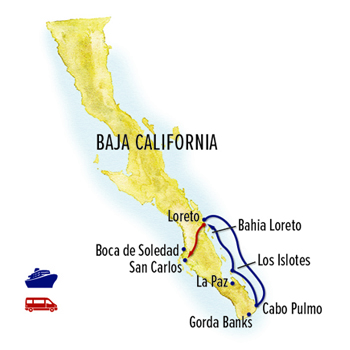Itinerary

Upon arrival at the airport in Loreto, transfer to the pier to embark the National Geographic Venture. Settle into your cabin and head up to the sundeck to admire the views as we prepare to sail at sunset. Should you arrive early, you may wish to explore the compact Old Town on your own. Founded in 1697 by Jesuit missionaries, Loreto’s colonial architecture is well preserved, centered on the peaceful town plaza. Loreto is the site of the first mission in Baja California—the Mission of Our Lady of Loreto.
Awake in Bahía Concepcion, one of the largest bays along the Baja Peninsula. More than 50 miles of pristine sandy beaches line the bay in this largely undeveloped region. Take your coffee up to the deck to witness the first of many luminous sunrises, with the dawn’s rays turning the arid landscape burnished gold. This whole area is a biodiversity hotspot ripe for exploration. Board Zodiacs in search of whales and other marine life, kayak through lush mangrove systems, and snorkel in pure, clear turquoise waters. On land, join a member of the expedition team for a hike among towering cacti, or stroll the beach as you learn about local ecology with our naturalist guides.
The Gulf of California, which divides the east shore of the Baja Peninsula from the Mexico mainland, is also called the Sea of Cortez—so named in 1539 for the Spanish conquistador Hernan Cortez who explored it earlier that century. This narrow body of water holds tremendous biological diversity where temperate and tropical waters meet, nurturing an abundance of marine life. Jacques Cousteau called it the “world’s aquarium,” home to many species of whales, dolphins, sea turtles, sharks, rays and fish, and sea lions. From the deck, we keep our eyes peeled for sightings. Our ship’s course is flexible as we explore some of the uninhabited islands that dot these waters. Our Captain and Expedition Leader collaborate to choose the perfect combination of destinations and activities for the day. Conditions permitting, you may have the chance to hike, kayak or paddleboard. Learn about this rich ecosystem from our naturalist staff, and capture memorable photos with help from our National Geograhic-certified photo instructor.
After breakfast, transfer by motorcoach from Puerto Escondido to Puerto Lopez Mateos on Baja’s Pacific coast. From here we’ll explore the tranquil waters of Boca de Soledad on the northern end of Magdalena Bay, a warm lagoon where gray whales give birth and nurture their young. Each winter, these massive whales make the world’s longest mammal migration, swimming south from their Arctic feeding grounds off Alaska to breed and birth their calves in these sheltered waters. Accompanied by local fishermen who have taken guests to see the whales for decades and are integral to their conservation, we head out in Zodiacs to view numerous mother-calf pairs. With luck, we’ll enjoy close-up interactions with these curious, gentle cetaceans. Birdwatching can be excellent here too, with magnificent frigatebirds, pelicans, cormorants, terns and great blue herons among the species we frequently see. We’ll eat lunch at a traditional restaurant before returning to the ship by late afternoon.

Our ship continues south down the Baja Peninsula’s east coast, bringing us into a realm of enticing islands and surrounding waters renowned for their prolific marine life, conservation achievements and exciting adventure opportunities. Some of the locations we may explore include:
Cabo Pulmo National Marine Park
In the East Cape region of Baja California Sur, snorkel the pristine reefs of Cabo Pulmo National Marine Park, one of the most successful national marine parks in the world. Surrounded by uninhabited desert and rugged mountains, Cabo Pulmo has successfully preserved pristine beaches along a shallow bay with the only hard coral reef in North America. The reef is approximately 20,000 years old, among the oldest in the American Pacific. Fishing is restricted, and the marine life in these waters is prolific. Chat with devoted locals whose advocacy drove the effort to persuade the Mexican government to protect this pristine place, including halting fishing to save the reef.
Isla Espiritu Santo
A national park as well as part of the UNESCO Espiritu Santo Biosphere Reserve, with volcanic rock formations, scenic beaches and coral reefs, this enticing island offers excellent hiking opportunities and crystal-clear waters for snorkeling. It’s also an important location for researchers monitoring sea turtles.
Los Islotes
Located at the northern end of the Biosphere Reserve, where deeply indented shorelines meet dramatically eroded cliff faces, Los Islotes are some of the most beautiful islands in the Sea of Cortez. Anchoring off the coast, we swim and snorkel here, with equipment and instruction provided by the ship’s expedition staff. A large colony of resident sea lions is at home here, and these curious creatures often swim right up to us, eager to play. You may wish to observe the islands’ rich geological history from a kayak, observing massive amounts of compacted volcanic ash covered with solidified lava floods, just yards from the shore. Seabirds abound, and brown pelicans, yellow-footed gulls and blue-footed boobies dot the landscape, nesting on the rugged cliffs.
Isla San Jose
One of the larger islands in the Gulf of California, San Jose offers several landing possibilities depending on conditions and the whim of the moment. Photograph the ochre cliffs of the island’s eastern shore, hike a cactus-laden arroyo, or visit the abandoned salt works on the west side, keeping an eye out for rare wildlife as you go.
With deeply indented shorelines and dramatically eroded cliff faces, Los Islotes are some of the most beautiful islands in the Sea of Cortez. We swim and snorkel here, with equipment and instruction provided by the ship’s expedition staff. Curious sea lions often swim right up to us, eager to play. There’s also a chance to observe the islands’ rich geological history from a kayak, observing massive amounts of compacted volcanic ash covered with solidified lava floods, just yards from the shore. Seabirds abound, and brown pelicans, yellow-footed gulls and blue-footed boobies dot the landscape. This afternoon, take in vibrant La Paz, the capital city of Baja California Sur. With its lively street art and bustling waterfront Malecon, you’ll feel the romance of authentic Mexican culture. Dinner this evening is an unforgettable cultural experience, complete with local cuisine, dancing and folklore.
The Gulf of California—also known as the Sea of Cortez, named in 1539 for the Spanish conquistador Hernan Cortez who explored it earlier that century—is home to tremendous biological diversity, and sightings of whales, dolphins, and other sea life are among the highlights of our journey. With the luxury of flexibility and no set plan, we explore a sampler of the Sea's many uninhabited islands today. Our captain and Expedition Leader will choose the optimal combination of activities for the day. Jacques Cousteau called the Sea of Cortez "the world's aquarium," and we get a feel for the aptness of that moniker as we scout for marine life. We may go ashore at Isla San Francisco, where a sweeping arc of white-sand beach fringes waters perfect for kayaking or stand-up paddleboarding. Or perhaps we'll visit Bahia de Los Muertos to snorkel among the coral. Rich in nutrients, the Sea of Cortez is home to a huge variety of fish, including king angelfish, surgeonfish, butterfly fish, damselfish and the vividly colored parrotfish.
After breakfast, disembark the ship and transfer to the Loreto airport for flights home or to the city center to begin a two-night history and whale-watching extension.
Note: This itinerary should serve as a guideline only; the actual stops are determined by weather, wildlife activity, and a host of factors in order to provide the best possible experience. This flexibility is what makes traveling on our nimble expedition ships so much more rewarding than on a large vessel with a locked-in voyage plan.

































